Abstract
In order to investigate the transport law of an unsteady wake in a downstream cascade channel in a turbine stage environment, this study was based on a self-designed unsteady wake generator, and a low-pressure turbine cascade was the research object. The research was carried out through a combination of experiments and numerical simulation. The results show that in the range of −50° to 20° inflow incidence, there is no separation on the blade suction surface, the total pressure loss coefficient is low, and the cascade has good adaptability to the inflow incidence. When the incoming flow is at a negative incidence, the transport of the unsteady upstream wake to the downstream unsteady wake is basically the same; the same holds for a non-negative incidence. When the upstream unsteady wake is transported downstream in the cascade channel, the wake near the cascade suction surface follows a detour and barely interacts with the mainstream fluid. The total pressure loss fluctuation value obtained via numerical calculation shows good periodicity; therefore, the unsteady cascade effect under the action of upstream wake sweeping becomes very obvious.
1. Introduction
As one of the most important power components in aircraft engines, low-pressure turbines require excellent working performance under design conditions. In addition, variable working conditions are important indicators for measuring their mechanical properties. Jouini [1,2] and Benner et al. [3,4] found that through experimental study, the inflow incidence significantly influenced cascade profile loss and secondary flow loss. Pesatori [5] found that the inflow incidence has a significant influence on the development of secondary flow and the distribution of secondary flow energy loss by researching different inflow incidences. Therefore, it is necessary to study the aerodynamic characteristics of low-pressure turbine cascade flow fields under different inflow attack angles in detail.
The internal flow of turbines is essentially an unsteady phenomenon, and the unstable flow during the operation of turbines is mainly due to the relative motion between rotor blades and stator blades. The rotor–stator interference effect is an unsteady flow phenomenon that is recognized and valued at present. The most direct interference forms are potential flow interference and wake interference. Gallus [6] found that only when the cascade axial pitch is less than 10% of the chord length does the effect of the potential flow interference and wake interference remain on the same order of magnitude. With an increase in axial pitch, the wake interference effect becomes stronger and stronger, while the potential flow interference effect becomes smaller and negligible. Rhee [7] showed that this relative motion produces potential viscous interaction between blade rows, and the upstream blade wake is the main cause of blade interaction. Li [8] conducted in-depth research on the complex physical phenomena of blade wake transport mechanisms, which improved the understanding of the timing effects and aerodynamic response of wake transport. Touil et al. [9] conducted steady and unsteady flow simulations and analyzed the performance diagram of the rotor–stator interaction of a two-stage high-pressure axial flow turbine. Bohn [10] analyzed complex three-dimensional unsteady flow phenomena in multi-stage turbines in detail, focusing on the influence of the synchronization effect on the three-dimensional unsteady flow field and turbine performance. In order to further analyze the influence of rotor–stator interaction on the multi-stage turbine blades’ aerodynamic performance, Batailly [11] conducted experimental and numerical simulation studies on the single-blade rotor–stator interaction. As one of the essential real flow phenomena, the periodic unsteady effect caused by wake interference should be fully considered in the design of turbomachinery.
Wake sweep is one of the most important unsteady flow characteristics of low-pressure turbine blades. The unsteady effect of an upstream wake on downstream cascade has attracted increasing attention from researchers, and many outstanding results have been achieved. In view of the interaction between wake and downstream cascade, Meyer [12] conducted a detailed study and proposed that the influence of this interaction mainly arises from the unstable pressure distribution in wakes, which, in turn, originates from the velocity defect in upstream wake. Ning [13] and Pfeil [14], respectively, studied the wakes of cylinders and blades. They found that the structure of the far-field wake generated by the flow around the cylinder is similar to that of the cascade, which means that the study of the upstream wake sweep in the turbomachine can be carried out with the help of a cylinder.
Professor Hodson [15] of Cambridge University used wake simulation devices to replace real wake. His research results show that, in the absence of wake interference, large separation bubbles tend to appear in the suction surface boundary layer at a low Reynolds number, while in the presence of wake interference, separation bubbles are, to a great extent, suppressed. His results also showed that there is an optimal sweep frequency at each Reynolds number condition. Ladwig and Fottner [16] studied the influence of upstream wakes on downstream blade rows by changing the pitch of the cylinder. The experimental research shows that different cylinder pitches will form different flow wakes, which will lead to different flow losses in the cascade. There is an optimal cylinder pitch, and the wake generated by this pitch induces boundary layer transition to inhibit separation. At the same time, the flow loss is minimized in the cascade. Schulte and Hodson et al. [15] used a hot-wire probe to measure cascade suction surface boundary layer development under different wake sweep frequencies, wake intensities, and Reynolds numbers. Howell [17] used a moving bar system to simulate upstream wake, and the experiment found that for the same outlet section, the losses generated with wakes present were below those generated by the profile with no wakes present. Michelassi [18] conducted a direct numerical simulation (DNS) study on compressible flow in T106 linear cascade and found that incoming wake helps to reduce the size of or suppress the separation bubble. Vincentiis [19] studied the evolution of the boundary layer over a low-pressure turbine blade by means of direct numerical simulation with the aim of investigating the unsteady flow field induced by the rotor–stator interaction. It was found that the presence of the wake is associated with a region of low-momentum flow exhibiting high-velocity fluctuations, and passage of the wakes generated regions of low- and high-speed perturbations that advected through the blade passage. Kodama [20] changed the wake-passing frequency by adjusting the moving bar speed in the experiment and found that the additional loss due to incoming wakes increases with increasing wake-passing frequency.
Many studies have been carried out on the experimental and numerical aspects of the unsteady effect of an upstream wake on the cascade downstream. They all used the moving bar system to construct the upstream wake in the test, and they used the same physical model as the stage environment for calculation in the numerical simulation. However, for the aerodynamic characteristics of the cascade under an unsteady wake sweep, previous studies were limited to a single inflow incidence, and there are few studies on variable inflow incidence. Therefore, in this study, a set of unsteady wake generators that can meet the different inflow incidence adjustment requirements was adopted. A self-designed low-pressure turbine cascade was used as the research object, and the transport law of upstream unsteady wake in the cascade channel and its influence on the cascade aerodynamic characteristics were explored in a combination of experiments and numerical simulations. The turbine design work was guided by the results.
2. Experimental Methods
2.1. Experiment Facility
The experiments were carried out in the large-scale transonic cascade wind tunnel of Harbin Institute of Technology. The overall structure of the experiment facility is shown in Figure 1. The device was composed of a wind tunnel test rig and a wake generator. The enlarged figure at the lower right corner shows a physical diagram of the connection between the wake generator and the wind tunnel test rig.
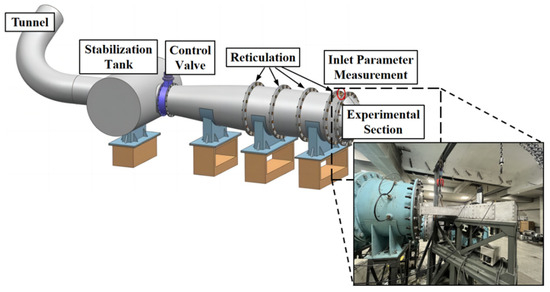
Figure 1.
The experimental facility’s overall structure.
The main components of the wind tunnel test rig are indicated in Figure 1. A stabilization tank was used in the wind tunnel test rig to achieve a stable airflow supply during the test. The gas flow required during the test was controlled via the control valve. The four reticulations at the wind tunnel test rig connection ensured that the turbulence of the airflow was normal in the experimental section. Before the airflow entered the experimental section, the total temperature and total pressure probe was installed in the parameter measurement area at the wind tunnel test rig inlet to carry out real-time monitoring of the flow field quality during the experiment. The centrifugal fan that provided the air source for the test wind tunnel had a power of up to 1 MW, a maximum pressure of up to 220 kPa, and a maximum flow of up to 10.5 kg/s. The inlet turbulence measured at the beginning of the experiment was about 4%, which ensured the normal operation of the experiment. Du [21] carried out relevant research on the turbine cascade end area in this experimental wind tunnel, and the measured value was also about 4%. The wind tunnel test rig had good inlet flow field uniformity, outlet flow field periodicity, and two-dimensional cascade flow. All of these were able to meet the requirements of the cascade experiment.
Figure 2 shows the wake generator’s internal structure, and Table 1 provides the wake generator’s relevant parameters. The device was equipped with a motor under the casing to drive the gear. In this device, a motor was installed below the casing to drive the gear to rotate so as to drive the moving bar fixed on the drive chain to produce a periodic wake at the leading edge of the blade. Here, the inflow incidence was adjusted by adjusting the relative position of the connection tunnel and the linear cascade test facility. During the test, all components were sealed in the casing, which largely prevented the interference of the external environment on the internal flow field.
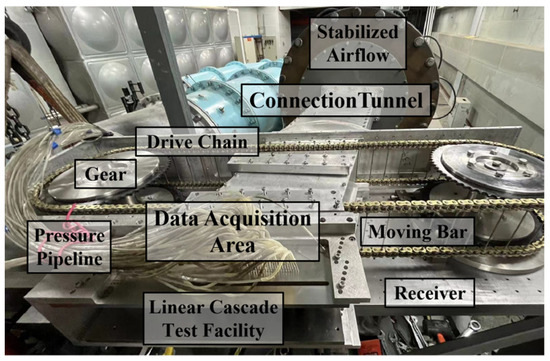
Figure 2.
Diagram of the internal physical structure of the wake generator.

Table 1.
Parameters of the wake-generating device.
The moving bar was designed with the principle of similar wake structures in mind. The wake distribution at the upstream blade outlet was obtained via numerical calculation of the stage environment under real conditions. When the moving bar’s diameter was 3 mm, the wake structure was basically similar. In the experimental process, if the diameter of the moving bar was too small, the rigidity could not meet the requirements, and the bar broke easily. If the diameter of the moving bar was too large, it increased the motor load and thus failed to reach the specified speed.
2.2. Rresearch Object
The research object of the experiment was a self-designed high-load, low-pressure turbine blade, the geometric parameters of which are shown in Table 2. Figure 3 shows the linear cascade test facility used for the experiment. The cascade chord length was 50.54 mm, the axial chord length was 40.60 mm, the blade height was 100 mm, the cascade pitch was 40.60 mm, and the geometric angles of the inlet and outlet were 19° and 63°, respectively. The inlet and outlet’s geometric angles were defined based on the axial direction. Therefore, the zero incidence was 19°, and the inflow incidence varied from −50° to 20° during the experiment. The linear cascade test facility had a total of eight blades to ensure that the collected flow field data demonstrated good periodicity.

Table 2.
Parameters of the blade geometry.
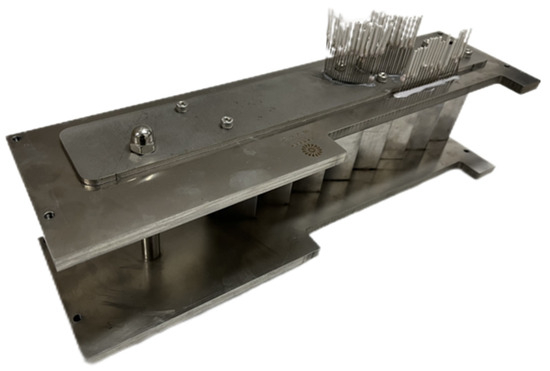
Figure 3.
Physical diagram the linear cascade test facility.
The formula for calculating the isentropic Mach number of a turbine cascade outlet is as follows:
κ is the specific heat ratio, which is 1.4 in the calculation process. Ptotal,inlet indicates the total pressure at the cascade inlet, and Pstatic,outlet indicates the static pressure at the cascade outlet.
During the experiment, the moving bar passed through the blade’s leading edge at a speed of 20 m/s in the direction of the circumference. The distance between the blade’s leading edge and the moving bar was 1.7 times the cascade’s axial chord length, the outlet isentropic Mach number was 0.75, and the inflow incidence was six angles ranging from −50° to 20° for the experiment.
According to the calculation formula for sweep frequency (2), the moving bar sweep frequency in this experiment was 0.17:
where C is the cascade chord length, vis_outlet is the exit isentropic velocity, Sb is the moving bar’s pitch, and Ub is the moving bar’s movement velocity.
2.3. Experimental Acquisition Method and Uncertainty
Data acquisition mainly included measuring the aerodynamic parameters at the cascade exit at 50% of the blade height during the experiment. When the inflow incidence was −40°, 0°, and 20°, the flow field distribution at the cascade outlet was collected. For pressure data acquisition in the flow field, the total pressure at the cascade inlet was connected to the pressure scanning valve through the inlet total pressure probe fixed on the connection tunnel. The cascade outlet static pressure was arranged by placing 21 static pressure holes equidistant from the top wall (0.4 times the axial chord length from the trailing edge within the middle two pitch distances) and then accessing the pressure scanning valve through the pressure pipeline. The relevant data of the flow field of the cascade outlet were collected with an L-shaped five-hole pneumatic probe fixed on the displacement mechanism. Due to the plane cascade symmetry along the blade-height direction, the acquisition area was from the middle two pitch distances of the cascade to 50% of the blade-height position. A total of 42 measuring points were set at the upper distance along the pitch direction, and 25 measuring points were set along the blade-height direction. At the same time, the encryption process was carried out in the end zone position using a total of 1050 measurement points. The five-hole probe sweeps from the pressure surface to the suction surface in the pitch direction and sweeps from the end wall in the radial direction. The probe displacement time combined with the data acquisition time was about eight seconds; thus, the total test time was close to three hours for each working condition. Figure 4 shows the L-shaped five-hole probe fixed on the displacement mechanism used in the experiment. In the process of acquiring the experimental data, the data from each pressure measuring hole was fed into the pressure scanning valve through the external pressure drawing pipe.
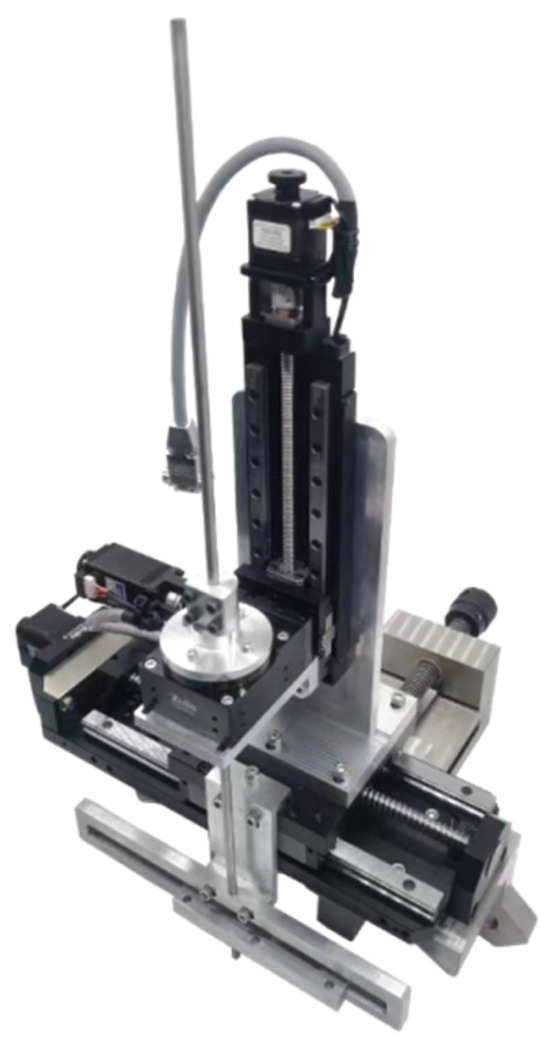
Figure 4.
An L-shaped five-hole probe fixed on a displacement mechanism.
During the experiment, the high-precision pressure scanning valve had a measuring range of 0-15PSI, the pressure measurement accuracy of each sensor channel was ±0.05%FS, and the pressure measurement error affected by temperature was ±0.001%FS in the calibration temperature range. The five-hole probe was calibrated using the method of Chen Y et al. [22]. The pitch angle and the airflow deflection angle were obtained by interpolating the calibration curve of the five-hole probe, with a measuring range of ±30° and a measuring accuracy of ±0.5°. The five-hole probe used was calibrated for pressure and flow direction, allowing data acquisition over a range of ±1° pitch and yaw angles. The total temperature and ambient temperature at the experimental section entrance were measured using a temperature sensor based on platinum wire thermal resistance, and the measurement accuracy of the resistance temperature used in the test was ±(0.15 + 0.002|T|) °C, where T is the collected temperature.
Experimental error is divided into two parts: machining error and measurement error. After an inspection of the coordinate measuring machine, the dimensional errors of the blade, hub, and shroud were less than 0.06 mm, and the machining error of the setting angle was less than 0.2 deg. According to Formula (3), the error transfer was calculated through the accuracy of each measuring device and combined with the error range of the angle measurement of the five-hole probe. In this manner, the system error value of each aerodynamic parameter could be obtained, as shown in Table 3.

Table 3.
Error calculation of aerodynamic parameters.
Here, the direct measurement parameters x1,x2,x3,…,xn are unrelated.
3. Numerical Method
3.1. Calculation Model
Due to the limited means of collecting experimental data, it is difficult to fully describe the flow field details through experiments alone. However, numerical simulations effectively capture flow field details and are also more economical and simple to operate than a test measurement. Therefore, it is necessary to use CFD numerical simulation to assist in the analysis of the flow in the flow channel and of the mechanism of action of the wake on the blade.
Figure 5 shows the fluid domain model during numerical simulation calculation; this model consists of two domains, ABCD-A′B′C′D′ and EFGH-E′F′G′H′. The inlet section ABA ‘B’ is equal to the axial chord length from the center of the moving bar. In order to prevent the numerical reflection of the outlet position from propagating into the separation zone and secondary flow zone, the outlet section HGH ‘G’ was set to be two times the axial chord length from the trailing edge of the blade. The sections ABCD/A′B′C′D′ and EFGH/E′F′G′H′ were set as periodic interfaces. The moving bar, blade, and upper and lower end walls were set to non-slip wall surfaces. We set the surfaces of CDD′C′ and EFF’E as the interface and used the fluent function to interpolate the overlapping part automatically to achieve the transfer of variables between the two domains.
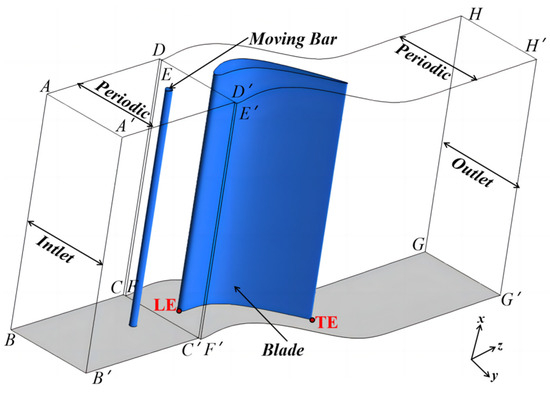
Figure 5.
Numerical calculation of the fluid domain model.
In the numerical calculation process, the inlet uses the total temperature, total pressure, and the inflow angle and the outlet uses the static pressure. The inflow incidence setting is consistent with the experimental conditions; that is, the zero incidence is 19°, and the inflow incidence varies from −50° to 20°. At the same time, the velocity of domain ABCD-A′B′C′D′ in the pitch (positive y-axis) direction is provided to achieve the purpose of wake sweep.
3.2. Numerical Calculation and Data Processing
For numerical calculation, we used the ANSYS Fluent 2022 R1 pressure-based solver. The three-dimensional, compressible, unsteady Reynolds-averaged Navier–Stokes (URANS) mean equation was solved using the pressure–velocity COUPLE algorithm. Reynolds averaging separates any variable into turbulent fluctuation and time-averaging flow, performs time-averaging processing on the variable, and then solves it with the corresponding turbulence model.
Here, are independent parameters in space, is an arbitrary variable that varies with time t and space parameters, is the turbulent fluctuation part of , is the time-sharing part of , and T represents a sufficiently long time to average the fluctuation in the variable .
In the unsteady wake sweep numerical calculation process, the second-order upwind scheme was adopted in space, and a second-order implicit format was adopted in terms of time. The moving bar moved a grid pitch in time as a cycle. Each cycle was divided into 120 steps, and each step was iterated 20 times. Table 4 shows the specific parameter settings in the unsteady state calculation process.

Table 4.
Parameter settings used in the calculation of an unsteady state.
When the monitoring parameters showed periodic changes, the calculation results were extracted after continuing for three cycles. The extracted calculation results were processed by applying the method of ensemble averaging [23]. For specific methods, refer to Formula (5):
3.3. Numerical Method Verification
Figure 6 shows the schematic diagram of the computational domain grid division that we used. The “O4H” grid topology was used to divide the two parts of the calculation domain. The “O” grid topology around the blade and the moving bar demonstrated good orthogonality, and the “H” grid was used for the inlet and outlet sections in order to ensure calculation accuracy of the turbulence model. The maximum thickness of the first layer of mesh from the wall was 0.001 mm to ensure that the y+ value was less than 1 in all aerodynamic conditions at the end wall and blade position.
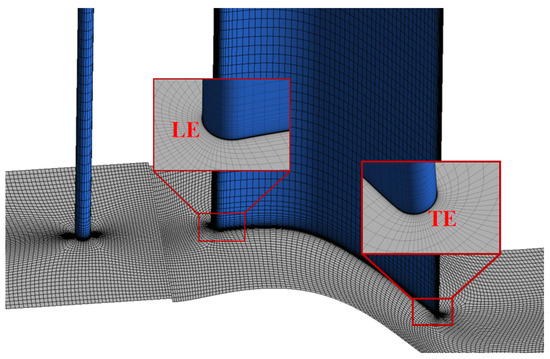
Figure 6.
Diagram of the structure of the grid division.
The calculation of the domain grid scale has a significant influence on the calculation results. In order to ensure that the calculation results are independent of the grid scale, the calculation domain grid was encrypted in five levels ranging from extremely coarse to extremely fine. The evaluation index is the total pressure loss coefficient of the entire calculation domain, and its calculation formula is as follows:
where P1t and P2t are the total pressure at each cascade outlet, and P2 is the static pressure at the cascade outlet, which is the ratio of the total pressure loss of airflow through the cascade to the outlet dynamic pressure.
Table 5 presents five sets of grid parameters selected for grid independence verification. The numerical calculation was carried out under the condition that the inflow incidence was 0° and the outlet isentropic Mach number was 0.75. The total pressure loss coefficient from the same outlet position of the cascade was compared, and the difference between this coefficient and that of the grid number and encryption level is shown in Figure 7. It can be seen that when the grid number reached the “Medium” level, the calculation result decreased with the change in the encryption level. Therefore, the grid level of “Medium” was selected in this study, which is sufficient to ensure that the grid is independent of the results of the calculation.

Table 5.
Mesh parameters selected to participate in grid independence verification.
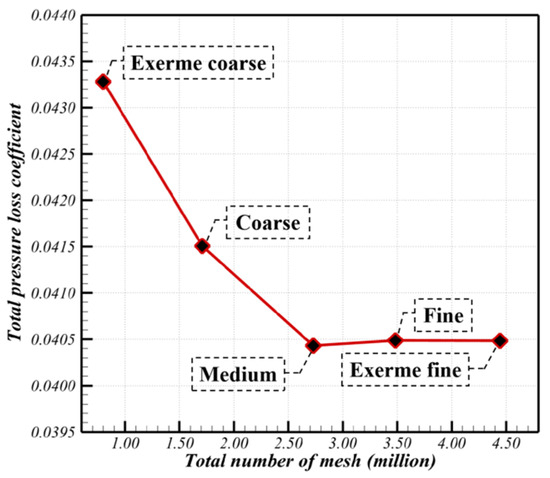
Figure 7.
Total pressure loss coefficient of different mesh numbers.
The American Society of Mechanical Engineers (ASME) and The International Gas Turbine Institute (IGTI) organized a Rotor37 blind test to evaluate the predictive power of the CFD tool at the 1994 conference. The test research showed that CFD codes of different turbulence models show extensive dispersion in the calculation results [24]; therefore, the selection of a turbulence model is also very important.
In this study, the k-Omega model of Wilcox [25], the two-equation k-Epsilon model of Yakhot [26], and the SST k-Omega model proposed by Menter in 1994 were considered, and the test results under the condition of an inflow incidence of 0° were selected to verify the turbulence model. The circumferential distribution of the two-pitch total pressure loss coefficient at the same coaxial position calculated using different turbulence models was compared with the test results, as shown in Figure 8. The horizontal coordinate is the dimensionless circumferential pitch, and the vertical coordinate is the total pressure loss coefficient. In comparison, it was found that the SST k-Omega model calculation results were in good agreement with the experimental data. Particularly at the highest loss point, the capture effect was better than that of other turbulence models. When studying such problems, Muth [27] used the SST k-Omega model for numerical calculation and compared these results with the experimental results. It was found that the experimental results were in good agreement with the numerical results. At the same time, this model considers the turbulent shear stress transmission and provides an accurate prediction of flow separation under an inverse pressure gradient. The superiority of this model has been confirmed in many studies by Menter [28]. Therefore, the SST k-Omega turbulence model was selected for study.
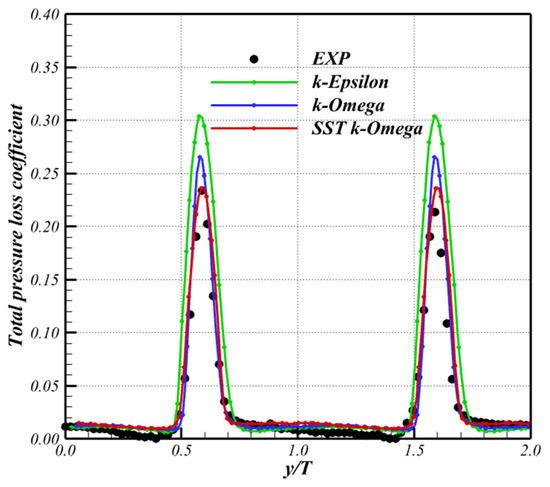
Figure 8.
Comparison of calculation results of different turbulence models with experimental results.
4. Results and Discussion
4.1. Overall Performance Analysis
Figure 9 shows a comparison between the experiment results and numerical calculation results on the cascade incidence characteristics; the horizontal coordinate is the inflow incidence, and the vertical coordinate is the total pressure loss coefficient. The comparison of the results shows that the numerical results are slightly higher than the experimental results, but the overall trend is consistent. Therefore, the SST k-Omega turbulence model is reliable for in-depth analysis of flow field details. In addition, it can be seen from the figure that as the inflow incidence gradually increases from −50° to 20°, the cascade total pressure loss coefficient first decreases and then increases, and the loss is the least when the inflow incidence was −25°.
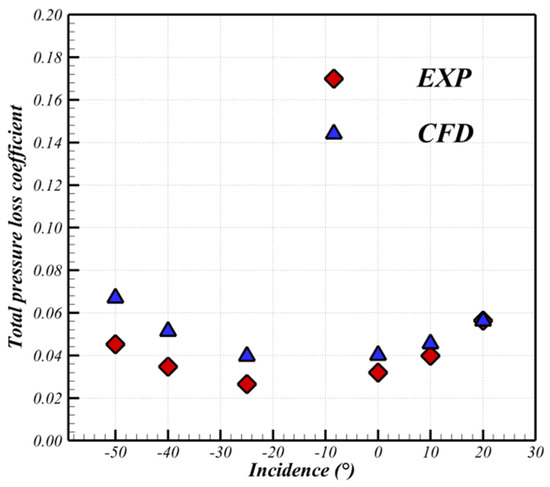
Figure 9.
Comparison of the experimental results and the numerical results on the cascade incidence characteristics.
The blade profile loss is generally regarded as a two-dimensional flow loss in low-pressure turbines. In order to further demonstrate the influence of upstream wake on blade profile loss in the blade middle section and explain the influence of inflow incidence on the blade suction surface and pressure surface boundary layer, the circumferential distribution of the total pressure loss coefficient at the blade exit in the middle section under different incidences was measured experimentally, as shown in Figure 10. Figure 11 shows the circumferential distribution results of the cascade total pressure loss at each inflow incidence on the same outlet obtained via numerical calculation. In the figure, the horizontal coordinate is the dimensionless circumferential pitch, and the vertical coordinate is the total pressure loss coefficient for (a) inflow incidence of i = 0°/−50°/−40°/−25° and (b) inflow incidence of i = 0°/10°/20°. During the experiment, the five-hole probe sweeps from the pressure surface side at the cascade at 50% of the blade height to the suction surface side and collects parameters within two pitch intervals. The highest point in the figure is the maximum loss value collected in the experiment and its corresponding position. As can be seen from the figure, under most working conditions, the experiment results within the two pitches have good periodicity. In addition, it can be seen that as the inflow incidence gradually increases from −50° to 0°, the space occupied by the region with higher total pressure loss gradually shrinks, and the boundary layer separation strength on the pressure side gradually weakens. As the inflow incidence gradually increases from 0° to 20°, the area with higher total pressure loss occupies a larger space, and the peak loss value increases gradually. The numerical results are basically consistent with the experimental results.
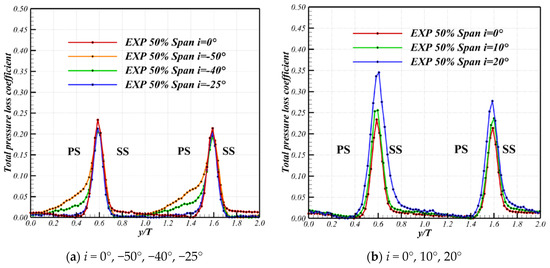
Figure 10.
Circumferential distribution of the total pressure loss coefficient at cascade outlet under different inflow incidences in the experiment.
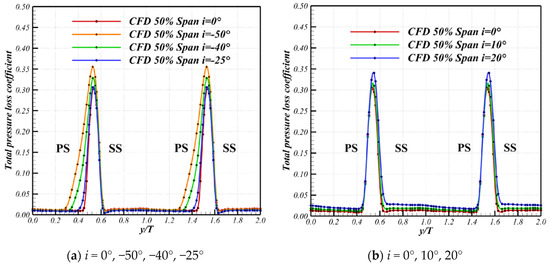
Figure 11.
Circumferential distribution of the total pressure loss coefficient at cascade outlet under different inflow incidences according to numerical calculation.
Figure 12 shows the vorticity distribution in the cascade end wall region when the inflow incidence is 0. It can be seen that the passage vortex, the shed vortex/counter vortex, and the corner vortex are the main sources of loss for the secondary flow in the end wall region. Figure 13 shows the total pressure loss distribution in the cascade end wall region when the inflow incidence is 0. It can be concluded that the high-loss area behind the low-pressure turbine grid is mainly caused by these vortex system structures.
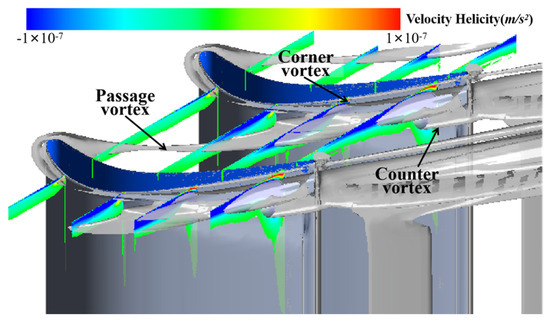
Figure 12.
Vorticity distribution in cascade end wall region.
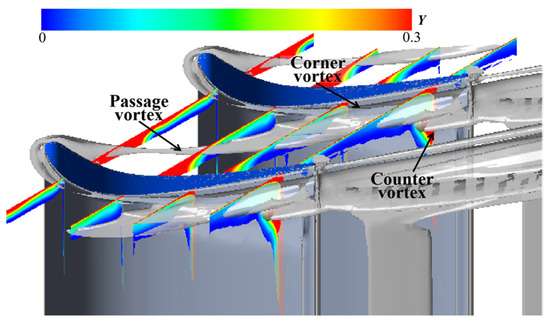
Figure 13.
Total pressure loss distribution in cascade end wall region.
In order to clarify the structure evolution law of the vortex system in the end wall region of low-pressure turbines under unsteady wake, the cascade outlet flow field parameters were collected under typical conditions during the experiment. Figure 14 shows the two-pitch distribution cloud diagram of the cascade outlet total pressure loss measured in the experiment under three-inflow incidence working conditions (i = −40°/0°/20°), respectively. Due to the plane cascade symmetry along the blade-height direction, the figure only shows the cloud images’ distribution within the range of 50% of the blade height. The horizontal coordinate is dimensionless pitch, and the vertical coordinate is dimensionless blade height. Figure 15 shows the total pressure loss coefficient’s radial distribution at the cascade outlet under different inflow incidences measured in the experiment.
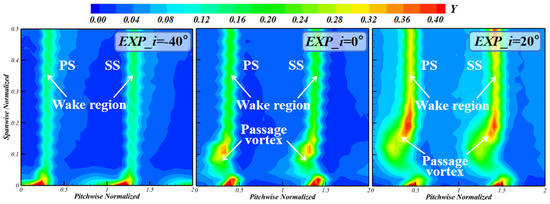
Figure 14.
The cascade outlet’s total pressure loss in two-pitch distribution under different inflow incidences.
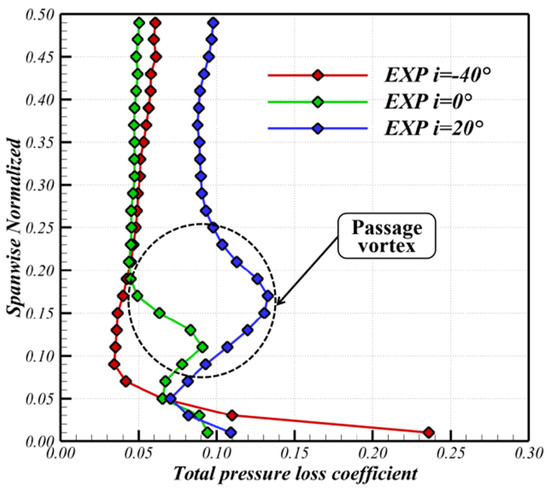
Figure 15.
The spanwise distribution of the cascade outlet’s pressure loss under different inflow incidences.
The experiment’s results show that the passage vortex losses are almost nonexistent in the negative inflow incidence range. As a result, the losses are mainly concentrated in the wake and the end wall region. As the inflow incidence increases, the transverse pressure gradient gradually increases, resulting in the end wall region fluid expanding significantly to the cascade middle and the pressure surface side and then gradually developing into the passage vortex. In addition, with the increase in inflow incidence, the passage vortex scale also gradually increases, resulting in a more intense C-type distribution in the cascade wake area. The loss also increases sharply in the area where the passage vortices are located. Further, it can be observed that as the inflow incidence increases to zero, the high-loss area decreases, and the high-loss area increases slightly as the inflow incidence gradually increases from zero to positive.
4.2. Flow Characteristics of Cascade Midsection under Wake Sweep
In order to clarify the overall influence of unsteady upstream wake sweeps on cascade losses at different times, six working conditions were calculated in numerical simulations in the cascade test. Figure 16 shows the cascade’s total pressure loss fluctuation in five periods at each inflow incidence under the unsteady upstream wake sweep. The horizontal coordinate is the time scale, and the vertical coordinate is the total pressure loss coefficient for (a) inflow incidence of i = 0°/−50°/−40°/−25° and (b) inflow incidence of i = 0°/10°/20°. The cascade calculation results show good periodicity in each working condition, which indicates that the unsteady cascade effect is very clear under the action of upstream wake sweep. Furthermore, it was found that when the inflow is in the negative incidence range (i = −50° and i = −40°) and positive incidence range (i = 10° and i = 20°), the cascade’s total pressure loss shows a high consistency. When the inflow incidence is −25°, the trend of the cascade’s total pressure loss change is similar to that of two large negative incidences. When the inflow incidence is zero, the cascade total pressure loss change law is basically the same as that of the positive incidence, but the change near the minimum value is more gentle than that of the positive incidence. As time goes on, since the loss is different at the blade’s leading edge during the unsteady upstream wake sweep process, the moving bar position corresponding to the lowest loss can be roughly determined and then combined with the corresponding active/passive control technology. In this manner, the aim of reducing loss can be achieved.
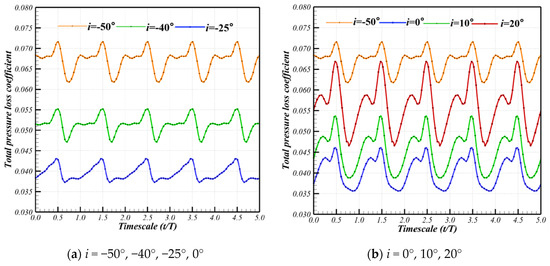
Figure 16.
The distribution of the cascade’s total pressure loss under different inflow incidences.
The isentropic Mach number distribution of the blade profile explains the strength of the blade passage’s transverse pressure gradient and reflects the location and size of the separation bubble on the blade surface, which is an important parameter to show the separation vortex scale in the blade passage. The isentropic Mach number can be used to understand the physical phenomena of acceleration and deceleration flow, air separation, or reattachment in the area near the blade wall so as to evaluate the blade’s aerodynamic performance.
Due to the limitations of the experiment, the blade’s profile parameters could not be collected during the experiment. In this study, the distribution of the isentropic Mach number of the profile of the blade’s middle section under different inflow incidences in the time-averaged state was obtained via the numerical calculation method, as shown in Figure 17. The horizontal coordinate is the blade’s relative axial chord length, and the vertical coordinate is its isentropic Mach number for (a) inflow incidence of i = 0°/−50°/−40°/−25° and (b) inflow incidence of i = 0°/10°/20°. It can be concluded that in the whole inflow incidence range, the maximum isentropic Mach number of the blade suction surface is about 0.52 times the axial chord length, and the blade loading ability gradually increases with the increase in inflow incidence. The boundary layer of the blade suction surface is under the action of a downward pressure gradient in the region from 0 to 0.52 times the axial chord length, and the isentropic Mach number reaches its peak at 0.52 times the axial chord length. After that, there is a continuous deceleration and diffusing process, with no obvious “pressure convex hull” phenomenon caused by bubble separation. Therefore, the boundary layer of the blade suction surface does not separate in the whole inflow incidence range. Further, it can be seen that as the inflow incidence gradually increases from −50° to 20°, the separation vortex scale occupying the first half of the blade pressure side gradually decreases and disappears at 0°.
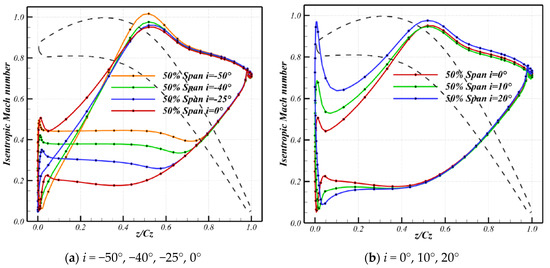
Figure 17.
Distribution of the isentropic Mach number at the cascade’s middle section under different inflow incidences.
The tangential stress in the flow direction can more directly reflect the flow structure on the blade surface. When the tangential stress is greater than zero, the nearby fluid velocity is consistent with the mainstream. When the tangential stress is less than zero, the nearby fluid velocity is opposite to the mainstream. At this time, if the fluid is close to the wall, it means that the wall boundary layer is separated. Figure 18 shows the tangential stress distribution of the blade surface along the flow direction at different inflow incidences. The horizontal coordinate is the blade’s relative axial chord length, and the vertical coordinate is the tangential stress along the flow direction for (a) inflow incidence of i = 0°/−50°/−40°/−25° and (b) inflow incidence of i = 0°/10°/20°. It can be seen from the figure that the tangential stress on the suction surface side is greater than zero in all the inflow incidence ranges; therefore, the boundary layer of the blade suction surface does not separate in the whole inflow incidence range. As the inflow incidence increases from −50° to 0°, the negative tangential stress on the blade-pressure side decreases gradually, and the tangential stress is greater than zero at 0° incidence, which means that as the inflow incidence gradually increases from −50° to 0°, the separation vortex scale occupying the first half of the blade-pressure side gradually decreases and disappears at 0° incidence.
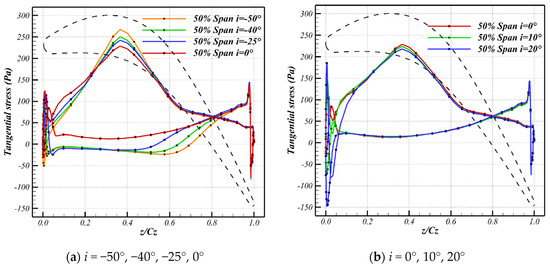
Figure 18.
Tangential stress distribution along the flow profile at the cascade’s middle section under different inflow incidences.
The turbulent kinetic energy (TKE) cloud diagram can clearly show the transport process of the unsteady upstream wake in the cascade channel. In this paper, the influence of different inflow incidences on the unsteady upstream wake transport in the cascade channel is illustrated via the numerical calculation method. Figure 19 shows the various inflow incidence. At 50% blade height (S1), the flow surface of the unsteady upstream wake flows downstream of the cascade channel under one time period, as shown in the turbulent kinetic cloud diagram. As can be seen from the figure, the unsteady upstream wake gradually approaches the front edge of the suction in one period and then interacts with the blade to leave the pressure surface. In this study, the inflow incidence of 0° is used as an example to illustrate the unsteady upstream wake transport process in the cascade channel during one period.
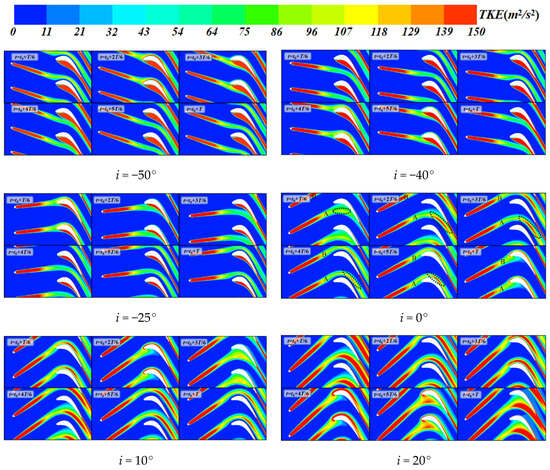
Figure 19.
Cloud diagram of the turbulent kinetic energy at the cascade’s middle section under different inflow incidences.
At the time t = t0 + T/6, wake A generated by the moving bar enters the cascade channel, and in the process of energy exchange with the mainstream fluid, the core turbulent kinetic energy decreases continuously. In the cascade channel, due to the effect of lateral pressure gradient, the wake region fluid interacts more frequently with the mainstream fluid; therefore, the core’s turbulent kinetic energy gradually increases (as shown in the black dashed box). With the passage of time, this fluid gradually approaches the blade suction surface until time t = t0 + T, when it attaches to the suction surface boundary layer and exchanges momentum and energy with it to increase its turbulent kinetic energy.
Through the graph at time t = t0 + T/6/t = t0 + 2T/6/t = t0 + 3T/6/t = t0 + 4T/6, the unsteady upstream wake flow in the cascade channel’s postmedian can be clearly observed. When wake A is transported downstream from the leading edge into the cascade channel, because the flow velocity on the pressure surface side is lower than the main flow velocity, the wake velocity near the pressure surface is slower. Therefore, wake A is wider in the circumferential direction, and its width is gradually reduced as wake A gradually separates from the pressure surface. When t = t0 + 4T/6 is about to arrive at the suction surface, wake A is transported downstream along the suction-surface side without interacting with the fluid near the suction surface because the whole flow process is in the pressure gradient, the suction surface’s boundary layer has not been separated. At the time t = t0 + T, it can be seen that wake A is stretched into an S-shape because the velocity of the cascade suction/pressure surface boundary layer is low, and the velocity in the mainstream area is high. Driven by the incoming flow, the velocity difference between the wake center and the wake’s two ends gradually increases, and the S-shaped wake becomes more obvious. Then, the wake will act on the pressure surface boundary layer, and the next wake will enter the cascade channel, etc.
By comparing the unsteady upstream wake transport process to the downstream wake transport process under various working conditions, it can be found that the transport process is basically the same when the incoming flow possesses negative inflow incidence, while the transport process is highly similar when the incoming flow is zero and possesses positive inflow incidence. Therefore, this problem can be divided into negative incidence and non-negative incidence.
When the incoming flow is at a non-negative incidence, the unsteady upstream wake’s width gradually decreases until it breaks away from the pressure surface during the interaction between the unsteady upstream wake and the pressure surface’s boundary layer. However, when the incoming flow is at a negative incidence, the wake width hardly changes when it interacts with the pressure surface’s boundary layer. This is because the pressure surface’s leading edge is separated, and the intensity of turbulent kinetic energy outside the separation area is not much different from that of the wake. At the same time, the momentum and energy exchange between the two are weak. However, the incoming wake can effectively weaken the pressure surface’s boundary layer development. In addition, it can be found that when the incoming flow is at a non-negative incidence, the wake action on the front edge of the blade’s pressure surface is stretched into an S-shape and that the larger the inflow incidence, the more obvious the S-shape effect is. When the incoming flow is at a negative incidence, there is no obvious S-shape effect. By comparing the flow field structure under different working conditions, it can be found that the high turbulent kinetic energy region of the pressure surface’s separation bubble gradually shrinks, and the flow gradually becomes stable when the inflow incidence gradually increases from −50° to −25°. When the inflow incidence gradually increases to 20°, the exchange of energy and momentum between the unsteady upstream wake and the main stream becomes more and more frequent, resulting in a more complex flow field structure and increasing unstable flow. In all working conditions, when the wake is transported downstream in the cascade channel near the suction surface, the wake follows a detour and almost does not interact with the mainstream fluid on the suction surface. This occurs because the suction surface boundary layer of the blade is not separated in the whole range of the inflow incidence.
Figure 20 shows the fluctuation range of the cascade’s total pressure loss under different inflow incidences. It can be seen that when the inflow incidence gradually increases from −50° to 20°, the range of the cascade’s total pressure loss fluctuation presents the same change law as the incidence characteristic; that is, it decreases first and then increases. According to an analysis of the cloud diagram of the turbulent kinetic energy in one period, it can be seen that this occurs because when the inflow incidence gradually increases from −50° to −25°, the flow field structure gradually becomes stable; therefore, the loss fluctuation value gradually decreases. As the inflow incidence increases to 20°, the flow becomes increasingly unstable. In particular, at 20°, the region of high turbulent kinetic energy occupies almost the entire flow channel, so the loss is the largest, and the loss fluctuation range is the largest.
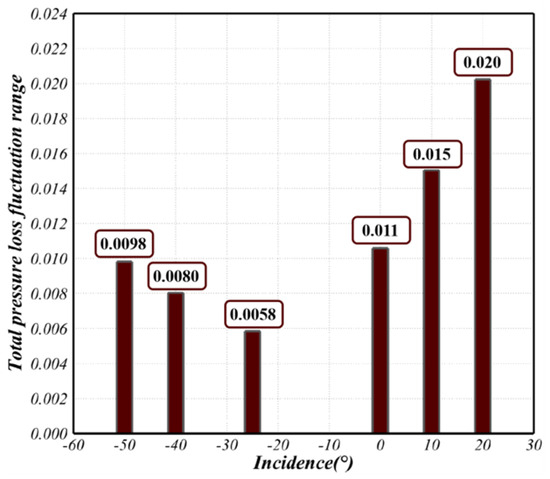
Figure 20.
The range of the total pressure loss fluctuation in one period under different inflow incidences.
4.3. Flow Characteristics of End Wall Region under Wake Sweep
Due to the different inflow incidences, under the wake’s negative jet-action mechanism, the blade profile’s isentropic Mach number changes, which mostly affects the development of the structure of the vortex system in the end wall region. Figure 21 shows the time-averaged results of the blade profile’s isentropic Mach number distribution at 95% blade height under different inflow incidences. The physical meaning of the horizontal and vertical coordinates is consistent with Figure 17, which will not be repeated here. It can be seen from the figure that when the incoming flow is at a negative incidence, the flow condition of the blade suction surface is good, and there is basically no separation. The pressure surface’s separation vortex scale is smaller than that of the middle section. For example, when the inflow incidence is −50°, the reattachment points at the 50% and 95% blade-height positions are about 0.44 and 0.55 times the axial chord length, respectively. Moreover, with an increase in the inflow incidence, the separation vortices’ scale gradually tends to be consistent at the two blade-height positions. When the inflow incidence is zero, the distribution curves of the isentropic Mach number basically coincide at the 50% and 95% blade-height positions.
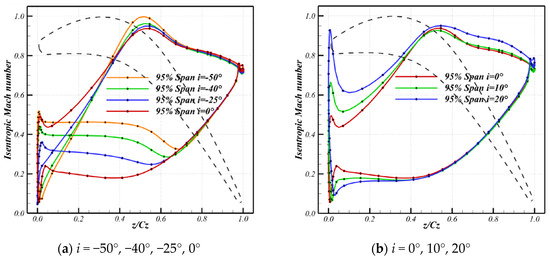
Figure 21.
Isentropic Mach number distribution of 95% high-profile surface under different inflow incidences.
Figure 22 shows the tangential stress distribution on the blade surface along the flow direction under different inflow incidences. It can be seen from the figure that in the negative inflow incidence range, the tangential stress distribution law is basically consistent with that of the blade middle section. At the end wall region, the separation occurs on the cascade pressure side when the incoming flow is at a negative incidence. Under other working conditions, the separation flow does not occur in a wide range.
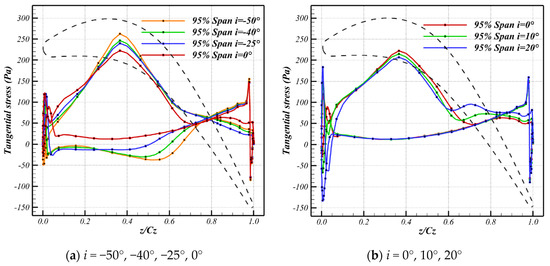
Figure 22.
Tangential stress distribution along the flow profile at the 95% blade height under different inflow incidences.
In order to further explain the transient action characteristics of the unsteady upstream wake against the secondary flow at each inflow incidence, it is necessary to deeply analyze the wake position and flow of each transient field characteristic. Figure 23 shows the total pressure loss distribution in each cascade section along the flow direction and the limiting streamlines’ distribution on the blade surface under different inflow incidences. The four sections in the figure are 0.25, 0.54, 0.74, and 0.94 times the axial chord length, respectively.
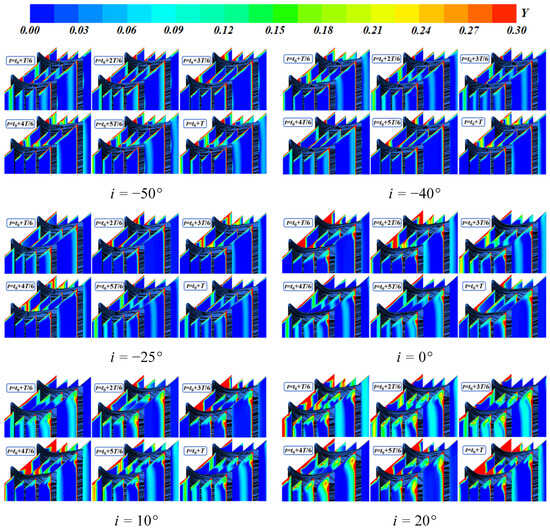
Figure 23.
Total pressure loss distribution along each cascade section and the limiting flow line on the blade surface under different inflow incidences.
Taking the inflow incidence from here as 0°, the variation process of the total pressure loss in the cascade channel within a period is simply illustrated. At time t = t0 + T/6, the high-loss wake generated by the moving bar enters the cascade channel and begins to exchange energy with the end wall region’s fluid near the leading edge of the pressure surface. As time goes by, during the time from t = t0 + 2T/6 to t = t0 + 4T/6, the high-loss wake gradually moves to the adjacent cascade’s suction surface, and in the process of moving, the wake’s total pressure loss decreases continuously in the same section. At the time t = t0 + 5T/6, the wake starts to interact with the vortex structure in the end wall region of the suction surface. When t = t0 + T, both sides of the cascade are wrapped by wakes, and then the wakes act on the cascade pressure surface. The next wake will also enter the cascade channel, the next wave will do the same, and so on.
By contrast, when the incoming flow is at a non-negative incidence, the wake generated by the moving bar interacts with the fluid near the end wall region. With an increase in the inflow incidence, the high-loss area occupies a larger area along the flow in the same section of the cascade because the passage vortex scale increases with the increase in the inflow incidence, and the interaction with the wake is more intense. Therefore, the loss caused by momentum exchange is also relatively high, which is also consistent with the conclusion obtained from the analysis of test results in Section 4.1, reflecting the reliability of experiment results.
Figure 24 shows the turbulent kinetic energy cloud at the 95% section of the cascade in a period at each time under all experimental conditions. When the inflow is at a negative incidence, the transport process of the unsteady upstream wake is basically the same as that of the middle section, but the high turbulent kinetic energy area on both sides of the blade is slightly reduced. When the incoming flow is at a non-negative incidence, the wake near the suction surface passes around the suction’s front part and interacts with the vortex system in the end wall region at the suction surface’s separation point. With an increase in the inflow incidence, the cascade channel area occupied by the region with highly turbulent kinetic energy gradually increases. When the inflow incidence is 20°, the highly turbulent kinetic energy region almost fills the whole cascade channel. In addition, when the unsteady upstream wake acts on the blade pressure surface’s front edge, it can be seen that it is stretched into an S-shape. With an increase in the inflow incidence, the S-shape effect becomes more obvious.
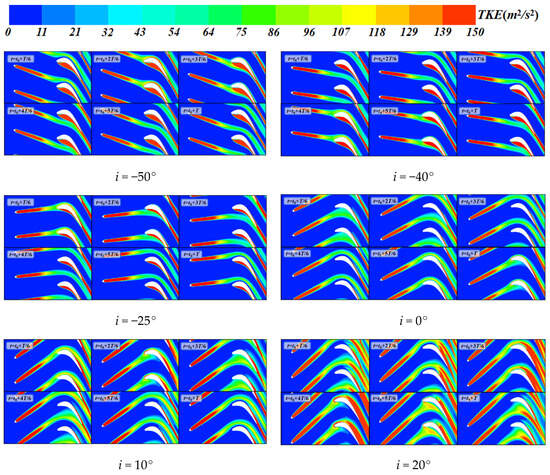
Figure 24.
Cloud diagram of the turbulent kinetic energy at the cascade’s 95% section under different inflow incidences.
5. Conclusions
In this paper, a low-pressure turbine cascade was used as the research object, and a self-designed, unsteady wake-generating device was used to conduct experimental research on this cascade. At the same time, the experimental phenomenon was supplemented with numerical simulation. The transport law of unsteady upstream wakes in cascade channels and the turbine cascade’s aerodynamic characteristics were investigated under different inflow incidences. At the same time, the wake transport law was analyzed in the end wall region. The results are summarized as follows:
- (1)
- The experimental results show that the cascade’s total pressure loss coefficient decreased first and then increased as the inflow incidence increased from −50° to 20°, and the loss was the least when the inflow incidence is −25°. In the whole experimental inflow incidence range, there was no separation on the cascade suction surface. In particular, when the inflow incidence was 20°, the blade surface still did not separate. Therefore, this blade profile shows good flow characteristics. Thus, the cascade can be considered to be adaptable to the inflow incidence.
- (2)
- Through the numerical calculation, it was found that the unsteady upstream wake flow law is basically the same in the cascade channel when the incoming flow is in the negative incidence range, and the same is true when the incoming flow is in the non-negative incidence range. When the unsteady upstream wake is transported downstream in the cascade channel, the wake near the suction surface departs and hardly interacts with the suction surface’s mainstream fluid. This occurs because the blade suction surface does not separate in all incidences.
- (3)
- The cascade calculation results showed good periodicity in each working condition, which indicates that the unsteady cascade effect was very obvious under the upstream wake sweep. At the same time, it was found that the loss fluctuation range and the incidence characteristic curve in one period showed the same law.
- (4)
- The test results show that the passage vortex losses were almost nonexistent in the negative inflow incidence range. As a result, the losses were mainly concentrated in the wake and the end wall region. In the positive inflow incidence range, with an increase in the inflow incidence, the passage vortex scale gradually increased, and the loss area of the passage vortex increased sharply.
Author Contributions
Conceptualization, X.L., X.F. and L.C.; methodology, L.C.; software, X.L. and L.W.; validation, X.L. and L.C.; formal analysis, X.L.; resources, X.F.; data curation, X.L.; writing—original draft preparation, X.L. and Y.C.; writing—review and editing, X.L. and X.H.; visualization, X.L. and Y.C.; supervision, S.W.; project administration, S.W. All authors have read and agreed to the published version of the manuscript.
Funding
This work was supported by the AECC Hunan Aviation Powerplant Research Institute.
Institutional Review Board Statement
Not applicable.
Informed Consent Statement
Not applicable.
Data Availability Statement
The data presented in this study are available on request from the corresponding author. The data are not publicly available due to privacy.
Conflicts of Interest
The authors declare no conflicts of interest.
References
- Woinowsky-Krieger, M.; Lavoie, J.P.; Vlasic, E.P.; Moustapha, H.S. Off-design performance of a single-stage transonic turbine. J. Turbomach. 1999, 121, 177–183. [Google Scholar] [CrossRef]
- Jouini, D.B.M.; Sjolander, S.A.; Moustapha, H.S. Midspan flow-field measurements for two transonic linear turbine cascadesat off-design conditions. J. Turbomach. 2002, 124, 176–186. [Google Scholar] [CrossRef]
- Benner, M.W.; Sjolander, S.A.; Moustapha, S.H. Measurements of secondary flows in turbine cascade at off-design incidence. In Proceedings of the ASME 1997 International Gas Turbine and Aeroengine Congress and Exhibition, Orlando, FL, USA, 2–5 June 1997. [Google Scholar] [CrossRef]
- Benner, M.W.; Sjolander, S.A.; Moustapha, S.H. Measurements of secondary flows downstream of a turbine cascade at off-design incidence. In Proceedings of the ASME Turbo Expo 2004: Power for Land, Sea, and Air, Vienna, Austria, 14–17 June 2004; pp. 1299–1311. [Google Scholar] [CrossRef]
- Pesation, E.; D’Ippolito, G.; Ippolito, G. Staggers angle and pitch-chord ratio effects on secondary flows downstream of a turbine cascade at several off-design conditions. In Proceedings of the ASME Turbo Expo 2004: Power for Land, Sea, and Air, Vienna, Austria, 14–17 June 2004; pp. 1429–1437. [Google Scholar] [CrossRef]
- Gallus, H.E.; Grollius, H.W.; Lambertz, J. The influence of blade number ratio and blade row spacing on axial-flow compressor stator blade dynamic load and stage sound pressure level. J. Eng. Power 1982, 104, 633–641. [Google Scholar] [CrossRef]
- Rhee, D.H.; Cho, H.H. Effect of vane/blade relative position on heat transfer characteristics in a stationary turbine blade: Part 1. Tip and shroud. Int. J. Therm. Sci. 2008, 47, 1528–1543. [Google Scholar] [CrossRef]
- Li, W.; Ouyang, H.; Du, Z. Numerical simulation of clocking effect on wake transportation and interaction in a 1.5-stage axial turbine. In Proceedings of the ASME Turbo Expo 2010: Power for Land, Sea, and Air, Glasgow, UK, 14–18 June 2010; pp. 1381–1389. [Google Scholar] [CrossRef]
- Touil, K.; Ghenaiet, A. Simulation and analysis of vane-blade interaction in a two-stage highpressure axial turbine. Energy 2019, 172, 1291–1311. [Google Scholar] [CrossRef]
- Bohn, D.; Ren, J.; Sell, M. Influence of stator clocking on the unsteady three-dimensional flow in a two-stage turbine. J. Turbomach. 2005, 127, 156–163. [Google Scholar] [CrossRef]
- Batailly, A.; Agrapart, Q.; Millecamps, A.; Brunel, J.F. Experimental and numerical simulation of a rotor/stator interaction event localized on a single blade within an industrial high-pressure compressor. J. Sound Vib. 2016, 375, 308–331. [Google Scholar] [CrossRef]
- Meyer, R.X. The Effect of wakes on the transient pressure and velocity distributions in turbomachines. Trans. ASME 1958, 80, 1544–1552. [Google Scholar] [CrossRef]
- Ning, W.; He, L. Some Modelling Issues on Trailing Edge Vortex Shedding. In Proceedings of the ASME 1999 International Gas Turbine and Aeroengine Congress and Exhibition, Indianapolis, IN, USA, 7–10 June 1999. [Google Scholar] [CrossRef]
- Pfeil, H.; Herbst, R. Transition procedure of instationary boundary layers. In Proceedings of the ASME 1979 International Gas Turbine Conference and Exhibit and Solar Energy Conference, San Diego, CA, USA, 12–15 March 1979. [Google Scholar] [CrossRef]
- Schulte, V.; Hodson, H.P. Unsteady wake- induced boundary layer transition in high lift LP Turbines. J. Turbomach. 1998, 120, 28–35. [Google Scholar] [CrossRef]
- Ladwig, M.; Fottner, L. Experimental investigations of the influence of incoming wakes on the losses of a linear turbine cascade. In Proceedings of the ASME 1993 International Gas Turbine and Aeroengine Congress and Exposition, Cincinnati, OH, USA, 24–27 May 1993. [Google Scholar] [CrossRef]
- Howell, R.J.; Ramesh, O.N.; Hodson, H.P.; Harvey, N.W.; Schulte, V. High lift and aft-loaded profiles for low-pressure turbines. J. Turbomach. 2001, 123, 181–188. [Google Scholar] [CrossRef]
- Michelassi, V.; Chen, L.W.; Pichler, R.; Sandberg, R.D. Compressible direct numerical simulation of low-pressure turbines—Part II: Effect of inflow disturbances. J. Turbomach. 2015, 137, 071005. [Google Scholar] [CrossRef]
- Vincentiis, L.D.; Ðurović, K.; Lengani, D.; Simoni, D.; Pralits, J.; Henningson, D.S.; Hanifi, A. Effects of upstream wakes on the boundary layer over a low-pressure turbine blade. J. Turbomach. 2023, 145, 051011. [Google Scholar] [CrossRef]
- Kodama, H.; Funazaki, K. Experimental investigation of additional loss associated with incoming wakes in low-pressure turbine cascades. J. Turbomach. 2024, 146, 051013. [Google Scholar] [CrossRef]
- Zhengshuai, D.; Le, C.; Jun, Z.; Yingjie, C.; Xun, Z.; Songtao, W. Experimental and numerical investigation on turbine flow control through integrating endwall contouring with section profiling at different Mach numbers. Aerosp. Sci. Technol. 2024, 151, 109318. [Google Scholar] [CrossRef]
- Chen, Y.; Jiang, D.; Du, Z.; Wang, S. Experimental and numerical investigation of high load turbine blade tip cavity structures. J. Turbomach. 2023, 145, 061008. [Google Scholar] [CrossRef]
- She, Z.S.; Chen, X.; Hussain, F. Quantifying wall turbulence via a symmetry approach: A lie group theory. J. Fluid Mech. 2017, 827, 322–356. [Google Scholar] [CrossRef]
- Shabbir, A.; Zhu, J.; Celestina, M. Assessment of three turbulence models in a compressor rotor. In Proceedings of the ASME 1996 International Gas Turbine and Aeroengine Congress and Exhibition, Birmingham, UK, 10–13 June 1996. [Google Scholar] [CrossRef]
- Wilcox, D.C. Multiscale model for turbulent flows. AIAA J. 1998, 26, 1311–1320. [Google Scholar] [CrossRef]
- Yakhot, V.; Orszag, S.A.; Thangam, S.; Gatski, T.B.; Speziale, C.G. Development of turbulence models for shear flows by a double expansion technique. Phys. Fluids 1992, 4, 1510–1520. [Google Scholar] [CrossRef]
- Muth, B.; Niehuis, R. Axial loss development in low pressure turbine cascades. J. Turbomach. 2013, 135, 041024. [Google Scholar] [CrossRef]
- Menter, F.R. Two-equation eddy-viscosity turbulence models for engineering applications. AIAA J. 1994, 32, 1598–1605. [Google Scholar] [CrossRef]
Disclaimer/Publisher’s Note: The statements, opinions and data contained in all publications are solely those of the individual author(s) and contributor(s) and not of MDPI and/or the editor(s). MDPI and/or the editor(s) disclaim responsibility for any injury to people or property resulting from any ideas, methods, instructions or products referred to in the content. |
© 2024 by the authors. Licensee MDPI, Basel, Switzerland. This article is an open access article distributed under the terms and conditions of the Creative Commons Attribution (CC BY) license (https://creativecommons.org/licenses/by/4.0/).